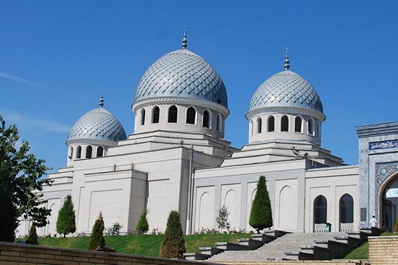The Old City, Tashkent
The Monuments of Medieval Architecture in the Old City of Tashkent
Tashkent is not only the capital of Uzbekistan but also one of the ancient cities of Central Asia. Like all other ancient cities, Tashkent preserves its old part which is just called the Old City. There residential houses built late in the XIX century can be found. There, in the territory of the Old City medieval architectural monuments such as the Kukeldash Madrasah, some of the buildings of Khast-Imam Complex are situated.
This is a historical north-western part of Tashkent where the city was located before the Turkestan general-governorship was formed in 1865. The name “Old City” came in the period of tsarist colonialism, when the Russian administration began building a new city. An unofficial border between the Old and New cities was the Anhor channel.
The majority of the architectural monuments in the territory of the Old City belong to the second half of the XV and the beginning of the XVI centuries. It was the period when the Shaybanids set it. When Tashkent was annexed to the Kokand khanate, the city was surrounded by a fosse and clay crenellation at length about 20 km with 12 gates. Unfortunately, the wall as well as the gates did not survive up to date.
Nowadays the most picturesque places of the Old City are located in the region of Chorsu Bazaar and Sebzar massive. A pearl of the Old City is the Khast Imam complex. It is a square where the Mausoleum of St Imam Kaffal Shashi after whom the complex was named, Islam Institute named after Imam al-Bukhari and the building of Spiritual Administration of the Muslims of Uzbekistan are situated. The central place in the square is occupied by a new Friday Jami mosque. Two minarets of 56m-high each are located along the both sides of the mosque. Opposite to the mosque, there is the Library of Spiritual Administration which holds one of the most respected and sacred relics of the whole Muslim world – caliph Osman’s Koran (VII century).
The mosque of Kaffal Shashi who lived in the beginning of the X century should be specially noted. Kaffal Shashi was thought to be one of the most enlightened persons of his time. When he was young he received training in the best-known madrasahs of Bukhara and Samarkand. Kaffal Shashi made khadj to Mecca and upon his return to the native land - Tashkent, he began propagating Islam and rules of the Shariah and for this activity he was awarded the title of Imam the Great. After his death in 976 his tomb became the place of Muslim pilgrimage. Later in 1541 under the Shaybanid, a mausoleum-khanaqah was built over his tomb. Up to now thousands of pilgrims come to the mausoleum to have blessing.
Directly next to the Khast Imam Complex there locates one of the oldest residential districts of Tashkent. It stretches till the “Chorsu” market which is also one of the oldest markets of Tashkent city. In front of the main entrance of the market, in the square, there locates the Kukeldash madrasah, the largest one out of the seventeen madrasahs in Tashkent. It was built in the XVI century by order of Tashkent khokim (ruler) – Dervish-khan, Kukeldash by nickname. The madrasah is operating up to present.
One of the other architectural monuments of the Old City is the Juma mosque of Khoja Ahrar Vali (main friday mosque of the city), which is located near to the Chorsu bazaar.
The Old City is not just one of the district of Tashkent; it is a unique monument where every single street and every single building has its own history.










